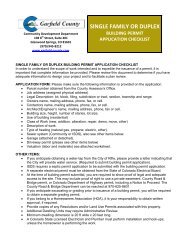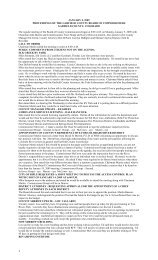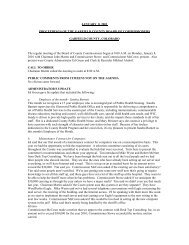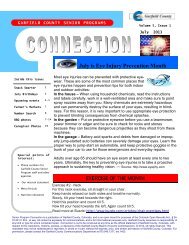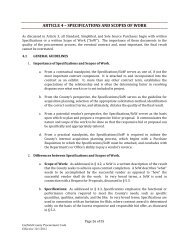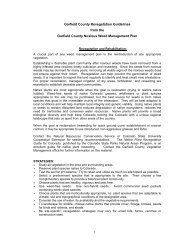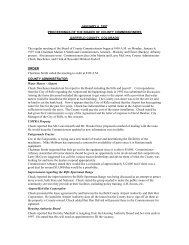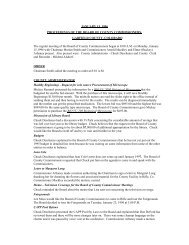Appendix D: Human Health Risk Assessment - Garfield County ...
Appendix D: Human Health Risk Assessment - Garfield County ...
Appendix D: Human Health Risk Assessment - Garfield County ...
You also want an ePaper? Increase the reach of your titles
YUMPU automatically turns print PDFs into web optimized ePapers that Google loves.
<strong>Appendix</strong> D Screening Level <strong>Human</strong> <strong>Health</strong> <strong>Risk</strong> <strong>Assessment</strong> February 2011<br />
Battlement Mesa, Colorado <strong>Health</strong> Impact <strong>Assessment</strong> Colorado School of Public <strong>Health</strong><br />
renal nephropathy in male rats, after inhalation of methylcyclohexane (Kinkead et al.<br />
1985)<br />
4.2.12 Methylene Chloride<br />
Sources of methylene chloride in ambient air include spray paints, household solvents<br />
and cleaners, and industrial solvents (ATSDR 2000a). A potential source associated with<br />
natural gas development and production is not clear. Fracking fluids and other chemicals<br />
cannot be ruled out as a source because of the unknown composition of the components<br />
used in these fluids.<br />
EPA has classified methylene chloride as a probable human carcinogen (Class B2) based<br />
on sufficient evidence in animal studies. Increased incidence of hepatocellular<br />
neoplasms, alveolar/bronchiolar neoplasms, mammary tumors, salivary gland sarcomas,<br />
and leukemia have been observed in studies on rats (EPA IRIS 1995/2010).<br />
Non-cancer health effects from exposure to methylene chloride in air include eye<br />
irritation and neurological effects. Inhalation of very high concentrations of methylene<br />
chloride can cause death. Inhalation of lower concentrations can cause dizziness, nausea,<br />
tingling or numbness of fingers and toes, and drunkenness. Symptoms usually disappear<br />
shortly after the exposure ends. Methylene chloride vapors also may cause eye irritation.<br />
(ATSDR 2000).<br />
4.2.13 n-Nonane<br />
Sources of n-nonane in ambient air include petroleum hydrocarbons and solvents<br />
(http://toxnet.nlm.nih.gov). Potential sources of n-nonane associated with natural gas<br />
development and production are the natural gas resource itself and fracking fluids<br />
containing diesel and other petroleum products (Antero has stated that it does not use<br />
diesel in fracking fluids).<br />
EPA has not determined a cancer classification for n-nonane.<br />
Evidence on human exposure to n-nonane is lacking. Central nervous system or<br />
peripheral nervous system abnormalities (tremors, convulsions, coordination loss, and<br />
limb paralysis) and irritation, as well as liver and lung lesions have been observed in rats<br />
exposed to n-nonane vapor (Carpenter et al. 1978; Nilsen et al. 1988).<br />
4.2.14 n-Pentane<br />
Sources of n-nonane in ambient air include petroleum hydrocarbons and solvents<br />
(http://toxnet.nlm.nih.gov). Potential sources of n-nonane associated with natural gas<br />
development and production are the natural gas resource itself and fracking fluids<br />
containing diesel and other petroleum products (Antero has stated that it does not use<br />
diesel in fracking fluids).<br />
<strong>Appendix</strong> D page 37



